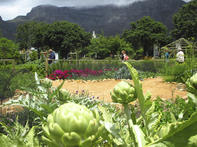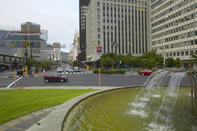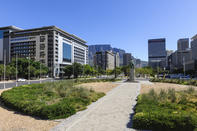Historical Garden
Cape Town was developed around the refreshment station established at the foot of Table Mountain by the Dutch East India Company in 1652.

Among the city's numerous historic treasures are the pentagonal Castle, built between 1666 and 1679, and the Cultural History Museum, erected in 1679 as slave quarters, and subsequently serving as government offices and a supreme court. The nearby Company's Garden was established in 1652 to supply passing ships of the Dutch East India Company with fresh produce, and between 1692 and 1783, it was developed into a world-famous botanical garden. This is a must see on South African holidays.
Adderley Street

Adderley Street is named after the British parliamentarian Charles Adderley, a staunch supporter of colonial self-government who endeared himself to Capetonians by opposing the extraordinary, also unacceptable and unsuccessful, attempt to transform the Cape into a penal colony during the mid-19th century.
Conspicuous is the War Memorial, which honours the city's soldiers who made the supreme sacrifice during the two World Wars and during the Korean War. Eye-catching is the statue of the founder of the city, Jan van Riebeeck, which was created by the sculptor John Tweed; next to him is the statue of Maria de la Quellerie, Jan van Riebeeck's wife.
It is interesting to note that the complex, and indeed major portions of the central area, are built over large underground canals of water, which mark the first attempts to run water from the mountain for use by the passing ships and townsfolk. Adderley Street, Strand Street and Riebeeck Street once formed the shoreline of Table Bay, more popularly known by the Dutch name of "Roggebaai" - Rocky Bay.
The Foreshore

At that time, cosy little fishermen's cottages were located along the shore, fish was dried in the sun, nets were mended, boats repaired, and a number of languages spoken. Also, the first locally built boat transported shale from Robben Island to the mainland, fish and seals from Saldanha and penguin eggs from Dassen Island, and water carts carried water everywhere along this busy shoreline.
Today the "Foreshore" covers remnants of these memories, as some 140 hectares of landfill covers the area, stretching north-easterly towards the busy Duncan Dock named after the first South African Governor General, Sir Patrick Duncan. Buitengracht Street, Outer Canal, marks what was once the western border of the old town.
Beach Road meanders along the periphery of the Victoria and Alfred Waterfront, a large commercial and leisure development designed around the original harbour. The Somerset Hospital, dating back to 1862, was named after Lord Charles Somerset. Here, Governor Sir George Grey laid the cornerstone and the country's very first medical students were trained. Nearby is Fort Wyngard, the site where the South African Coast Guard and Anti-Aircraft Artillery Museum are located.
Cape Town's City Centre has too many interesting features and sites to mention - it is best for visitors to walk from one place to the next, experiencing the ambience, and listening to the old city history recounted by the numerous locals who are so proud and loyal, that their stories bring tears to your eyes.